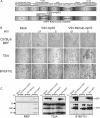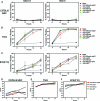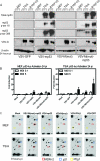Vesicular stomatitis virus expressing tumor suppressor p53 is a highly attenuated, potent oncolytic agent
- PMID: 21813611
- PMCID: PMC3187518
- DOI: 10.1128/JVI.05408-11
Vesicular stomatitis virus expressing tumor suppressor p53 is a highly attenuated, potent oncolytic agent
Abstract
Vesicular stomatitis virus (VSV), a negative-strand RNA rhabdovirus, preferentially replicates in and eradicates transformed versus nontransformed cells and is thus being considered for use as a potential anticancer treatment. The genetic malleability of VSV also affords an opportunity to develop more potent agents that exhibit increased therapeutic activity. The tumor suppressor p53 has been shown to exert potent antitumor properties, which may in part involve stimulating host innate immune responses to malignancies. To evaluate whether VSV expressing p53 exhibited enhanced oncolytic action, the murine p53 (mp53) gene was incorporated into recombinant VSVs with or without a functional viral M gene-encoded protein that could either block (VSV-mp53) or enable [VSV-M(mut)-mp53] host mRNA export following infection of susceptible cells. Our results indicated that VSV-mp53 and VSV-M(mut)-mp53 expressed high levels of functional p53 and retained the ability to lyse transformed versus normal cells. In addition, we observed that VSV-ΔM-mp53 was extremely attenuated in vivo due to p53 activating innate immune genes, such as type I interferon (IFN). Significantly, immunocompetent animals with metastatic mammary adenocarcinoma exhibited increased survival following treatment with a single inoculation of VSV-ΔM-mp53, the mechanisms of which involved enhanced CD49b+ NK and tumor-specific CD8+ T cell responses. Our data indicate that VSV incorporating p53 could provide a safe, effective strategy for the design of VSV oncolytic therapeutics and VSV-based vaccines.
Figures






Similar articles
-
Vesicular stomatitis virus as a flexible platform for oncolytic virotherapy against cancer.J Gen Virol. 2012 Dec;93(Pt 12):2529-2545. doi: 10.1099/vir.0.046672-0. Epub 2012 Oct 10. J Gen Virol. 2012. PMID: 23052398 Free PMC article. Review.
-
Experimental Evolution Generates Novel Oncolytic Vesicular Stomatitis Viruses with Improved Replication in Virus-Resistant Pancreatic Cancer Cells.J Virol. 2020 Jan 17;94(3):e01643-19. doi: 10.1128/JVI.01643-19. Print 2020 Jan 17. J Virol. 2020. PMID: 31694943 Free PMC article.
-
Retargeting Oncolytic Vesicular Stomatitis Virus to Human T-Cell Lymphotropic Virus Type 1-Associated Adult T-Cell Leukemia.J Virol. 2015 Dec;89(23):11786-800. doi: 10.1128/JVI.01356-15. Epub 2015 Sep 16. J Virol. 2015. PMID: 26378177 Free PMC article.
-
Vesicular stomatitis virus has extensive oncolytic activity against human sarcomas: rare resistance is overcome by blocking interferon pathways.J Virol. 2011 Sep;85(18):9346-58. doi: 10.1128/JVI.00723-11. Epub 2011 Jul 6. J Virol. 2011. PMID: 21734048 Free PMC article.
-
Immunovirotherapy Based on Recombinant Vesicular Stomatitis Virus: Where Are We?Front Immunol. 2022 Jun 28;13:898631. doi: 10.3389/fimmu.2022.898631. eCollection 2022. Front Immunol. 2022. PMID: 35837384 Free PMC article. Review.
Cited by
-
Oncolytic Virotherapy versus Cancer Stem Cells: A Review of Approaches and Mechanisms.Cancers (Basel). 2018 Apr 19;10(4):124. doi: 10.3390/cancers10040124. Cancers (Basel). 2018. PMID: 29671772 Free PMC article. Review.
-
Vesicular stomatitis virus as a flexible platform for oncolytic virotherapy against cancer.J Gen Virol. 2012 Dec;93(Pt 12):2529-2545. doi: 10.1099/vir.0.046672-0. Epub 2012 Oct 10. J Gen Virol. 2012. PMID: 23052398 Free PMC article. Review.
-
Win or loss? Combination therapy does improve the oncolytic virus therapy to pancreatic cancer.Cancer Cell Int. 2022 Apr 20;22(1):160. doi: 10.1186/s12935-022-02583-1. Cancer Cell Int. 2022. PMID: 35443724 Free PMC article. Review.
-
Oncotargeting by Vesicular Stomatitis Virus (VSV): Advances in Cancer Therapy.Viruses. 2018 Feb 23;10(2):90. doi: 10.3390/v10020090. Viruses. 2018. PMID: 29473868 Free PMC article. Review.
-
Emerging role of Natural killer cells in oncolytic virotherapy.Immunotargets Ther. 2015 Mar 31;4:65-77. doi: 10.2147/ITT.S55549. eCollection 2015. Immunotargets Ther. 2015. PMID: 27471713 Free PMC article. Review.
References
-
- Adkins B., Bu Y., Cepero E., Perez R. 2000. Exclusive Th2 primary effector function in spleens but mixed Th1/Th2 function in lymph nodes of murine neonates. J. Immunol. 164:2347–2353 - PubMed
-
- Angelo L. S., Talpaz M., Kurzrock R. 2002. Autocrine interleukin-6 production in renal cell carcinoma: evidence for the involvement of p53. Cancer Res. 62:932–940 - PubMed
-
- Arai K., Liu Z. X., Lane T., Dennert G. 2002. IP-10 and Mig facilitate accumulation of T cells in the virus-infected liver. Cell Immunol. 219:48–56 - PubMed
-
- Balachandran S., Barber G. N. 2004. Defective translational control facilitates vesicular stomatitis virus oncolysis. Cancer Cell 5:51–65 - PubMed
Publication types
MeSH terms
Substances
Grants and funding
LinkOut - more resources
Full Text Sources
Other Literature Sources
Research Materials
Miscellaneous

